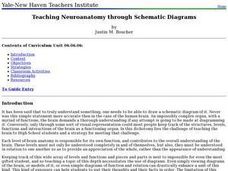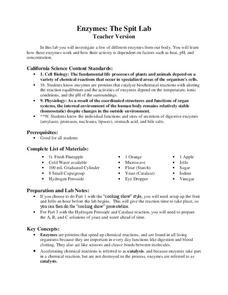Curated OER
Anatomy: Circulatory System
Young scholars use the Internet to research the circulatory system. They explore the different organs of the circulatory system and their functions. There are animations, online quizzes, games, and interactive tours of this system.
Curated OER
Teaching Neuroanatomy through Schematic Diagrams
Students identify the parts and function of a neuron. They explain and illustrate the levels and functions of the nervous system including neurons and the Central and Peripheral Nervous Systems. They analyze and diagram the Lobes and...
Curated OER
Protection, Support, and Locomotion
In this skeletal system worksheet, students will read a graphic organizer and complete 1 short answer question about the five functions of the skeleton. Then students will use a graphic organizer about muscle types to fill in a table...
Curated OER
Circulatory System Design
Students identify the different parts of the circulatory system and their function. They work together to create their own model of the system and use it to determine the rate of blood flow. They answer questions related to their model.
Curated OER
Nutrition 1: Food and the Digestive System
Students are introduced to how the digestive system works in their body. In groups, they discover they need energy and water to live a healthy life. They discover how the body repairs itself and how it grows. They also examine how...
Curated OER
Protection, Support, and Locomotion
In this vertebrate skeleton worksheet, middle schoolers will read a paragraph about the function of bones, muscles, and skin. Then students will complete 6 short answer questions.
Curated OER
Questions regarding the Digestive System
In this science related worksheet, learners locate and answer thirty three multiple choice questions regarding the digestive system in humans.
Curated OER
Exploring the Circulatory System: Getting to the Heart of It All
Seventh graders study how the heart functions and its parts. In this circulatory system lesson students learn how to take their pulse, blood pressure and respiration.
Curated OER
The Nervous System and the Effects of Drugs
In this nervous system worksheet, students read information about how the body receives and sends out information through the peripheral nervous system and central nervous system. Then students complete 3 short answer questions.
Curated OER
What's on Your Plate?
Students demonstrate the path of food in the body. In this biology activity, students conduct an experiment to determine how large the the digestive system is. They name the different organs involved in the digestive process.
Curated OER
Mythical Animals
Students create imaginary animals by assembling pictures of body parts from pictures of real animals. This is one of three linked tasks. The others are "Who's Parts Do I Have?" and "Animals Piece by Piece."
Curated OER
Plant Structure and Growth
This plant structure and function PowerPoint addresses the main organs and the factors that affect its development as well as going into detail about the specializations at a cellular level. The cell functions and system...
Curated OER
The Living Environment
Sixth graders show what they know about plant and animal cells. For this cell project lesson, 6th graders get to choose a project based on their learning style. They can create a visual representation of cells, auditory forms, or build a...
Curated OER
Stop the Bleeding
Learners explore various parts of the heart and blood vessels . They begin with an overview of the components of the cardiovascular system. They see a cross section of an artery and watch how a blood clot develops.
Curated OER
Your Kidneys
In this kidneys worksheet, students review the structure and function of the kidneys in the human body. This worksheet has 18 fill in the blank statements.
LABScI
Enzymes: The Spit Lab
Enzymes in our bodies each have a job to do. Learn the factors that affect the activity of some enzymes using the third activity of an informative 12-part biology series. A three-part laboratory activity asks teams to investigate how...
Curated OER
Help, I can't reach it!
Students learn the major organ systems in the human body and research simple machines on the Internet; They design an informational brochure about a medical profession and present that career topic to the class.
LABScI
Vision Lab: The Eye
Our bodies have some amazing capabilities, but there are some limitations. Explore the limitations of the human eye through the eighth lab activity in a series of 12 biology lessons. Individuals measure their own peripheral vision...
Curated OER
Meiosis Worksheet
These two pages cover the gamut of topics regarding reproduction and DNA replication. Structures, processes, functions, and reasons for them are tested here. The questions are mostly multiple choice, but there are also a few...
Curated OER
Nervous System
Get to know the body's central nervous system through an engaging game of nervous system telephone. But this isn't your average game of telephone. Here, pupils must find a way to communicate a message to the brain without speaking....
Curated OER
The Sense of Hearing
High schoolers study the cycle of how we listen and hear our own speech. They examine sound waves, and the role of the nervous system in hearing. They investigate the cues besides lipreading that deaf people rely on for comprehension.
Curated OER
Bodyworks
Students study about the different parts of their body and the names of bones as well. They gain an understanding of the function about the parts. Students follow along as the teacher guides them and points out various parts and their...
Curated OER
What Do We Have In Common?
Seventh graders perform a dissection on a mussels and label their internal organs. In groups, they compare and contrast the mussels structure to those of human beings. They also review the functions that are necessary for survival and...
University of Minnesota
Dendritic Spines Lab
This is your brain on drugs ... literally! Your neuroscientists-in-training examine the evidence of drug use on the human brain and how neurons change their connectivity when altered by drugs. They then work together to create testing...























